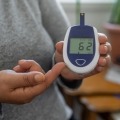Alpha Lipoic Acid for Diabetic Neuropathy: Does It Work?
By Patrick Sullivan
 Alpha-lipoic acid is an omega-3 fatty acid naturally found in food. Some studies suggest that supplementing with ALA may play a role in treating diabetic neuropathy.
Alpha-lipoic acid is an omega-3 fatty acid naturally found in food. Some studies suggest that supplementing with ALA may play a role in treating diabetic neuropathy.
You already know how important diet is for keeping a lid on diabetes symptoms and glucose levels.
If you live with diabetic neuropathy, a type of nerve damage resulting from diabetes, certain natural compounds found in foods may help slow progression and relieve symptoms.
One is called alpha-lipoic acid (ALA), and some studies suggest it may play a role in treating neuropathy. Additionally, as an antioxidant, it may be beneficial for keeping your cells and organs like your brain and liver healthy.
What does research say so far about ALA? Let’s find out.
What is alpha-lipoic acid?
ALA is an antioxidant found in foods like broccoli, spinach, and red meat. Your body’s cells also make it in small amounts.
Antioxidants are thought to protect cells against damage that, over time, can lead to chronic diseases making them crucial components of your immune system. Fruit, vegetables, and nuts are a few examples of foods rich in antioxidants. ALA is one antioxidant that early research has found may be beneficial if you have diabetes.
“ALA is considered more of a supplemental therapy that may have effects on diabetic neuropathy,” says Dr. Maamoun Salam, an associate professor of endocrinology at Washington University School of Medicine in St. Louis. “It also has some glucose-lowering effects.”
Alpha-lipoic acid is not to be confused with alpha-linolenic acid, an omega-3 fatty acid your body does not make. Same initials, different compounds.
Alpha-lipoic acid and neuropathy
When you have chronically high blood sugar, it can damage nerves and the small blood vessels that nourish your nerves. That’s how diabetic neuropathy is developed.
ALA may help neuropathy in multiple ways. On its own, it’s an effective antioxidant. Taking an ALA dietary supplement can also boost vitamin C and E levels, which in turn can increase your body’s supply of glutathione, another antioxidant. Together, these two antioxidants may clear free radicals – molecules that can cause cell damage – more efficiently.
That’s particularly important when you have diabetes as people with the condition either produce more free radicals, clear them slower, or both. Fewer free radicals may mean less nerve damage and milder diabetic neuropathy symptoms.
Dr. Salam points to a trio of trials of ALA in people with diabetes that showed improvements in pain, numbness, and paresthesia. However, he notes, the sample sizes were small and the study durations short, so it’s difficult to conclude whether ALA is effective for diabetic neuropathy.
Alpha-lipoic acid and glucose control
For people with diabetes, ALA may also extend beyond diabetic neuropathy treatment and aid blood sugar management.
Researchers suggest ALA works by binding to certain insulin receptors in liver cells. The compound has been called an insulin-mimetic agent, meaning it mimics the effects of insulin. Though research is limited to animal studies, the increase in the antioxidant glutathione that results from ALA supplementation may play a role in glucose management.
How to get ALA
All cells in the body naturally produce some ALA. You can get more through foods such as:
-
Brussels sprouts
-
Organ meats like liver
-
Red meat
-
Rice bran
-
Tomatoes
-
Spinach
-
Yeast
You can also get it from dietary supplements, though it’s important to note these are expensive. Since ALA is both water- and fat-soluble, you don’t need to take it with food like you would with a purely fat-soluble compound such as vitamin D.
Possible side effects of ALA
ALA is a dietary supplement and therefore does not require the same level of evidence and rigorous scientific testing as a pharmaceutical medicine. Similar to other dietary supplements, it only needs to be considered safe and effective by the U.S. Food and Drug Administration to be sold.
ALA is not generally found in tablets or capsules greater than 600 mg because studies suggest that higher doses are not more effective. Side effects can include:
-
Dyspepsia (indigestion, sour stomach)
-
Nausea
-
Vomiting
Rare cases have been reported in which ALA appears to have induced insulin autoimmune syndrome, a rare type of hypoglycemia caused by too many insulin autoantibodies.
Is ALA right for you?
“Sometimes I will offer it as add-on therapy for those who do not wish to switch to another approved agent or increase the dose of an agent they are using because they want to avoid side effects,” said Salam.
Speak to a healthcare professional before trying dietary supplements like ALA. Supplements are no substitute for being mindful about diet, physical activity, maintaining a healthy weight, and taking any and all prescription medications as directed.
Learn more about treatments for diabetic neuropathy here:








